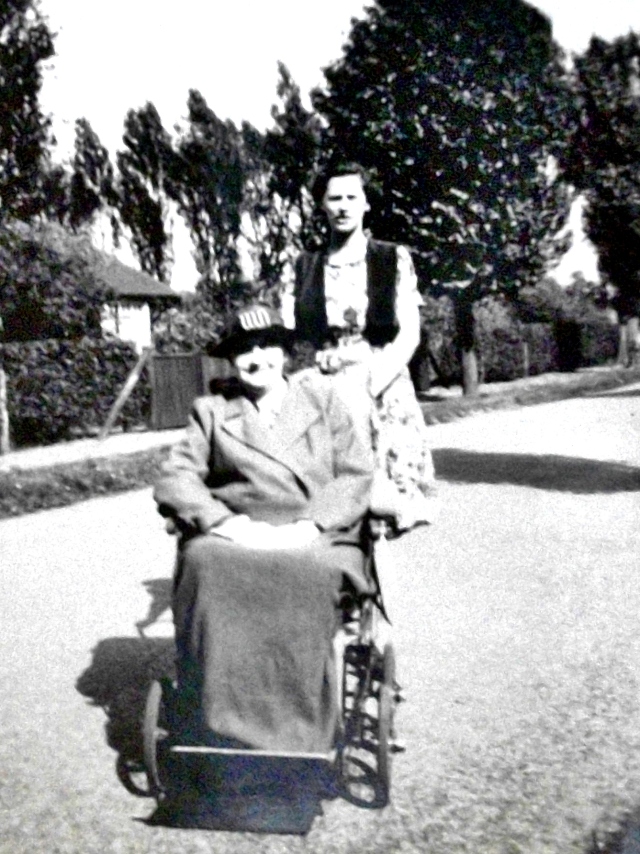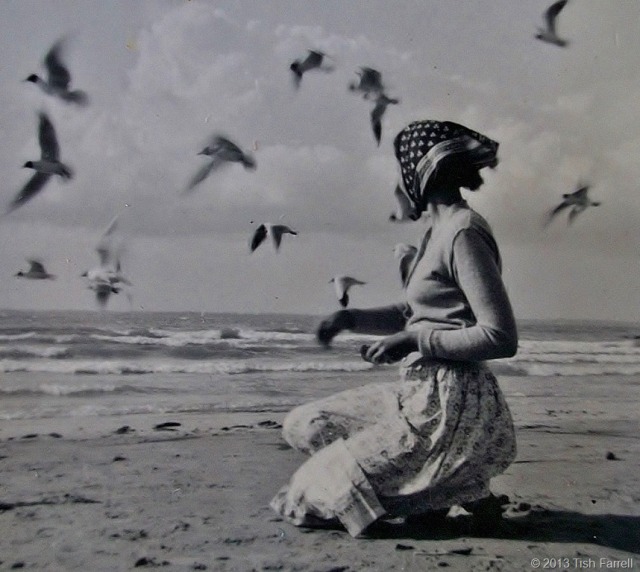Pitch Hill, Cranleigh, Surrey
*
Don’t you feel the rush of energy as you look at this photograph? An impulse captured, hopefulness personified. The gaze is so sure, the balance perfect with no hint of a wobble. It makes you ask: what is this young woman surveying? How does she see her future? And with a stance like that, isn’t it bound to be glowingly brilliant?
If I tell you that the year when this snap was taken was 1937, whatever image you have just conjured will fragment into uncertainty. With hindsight we can see what her young eyes cannot: soon there will be war, some six years of it.
This, then, is my aunt, Evelyn Mary Ashford, who was ninety in June 2013. I have told the story of the 1942 train bombing that she miraculously survived here. But since I wrote that post I have found an aftermath photo of the actual incident.
Photo from War on the Line by Bernard Darwin, Middleton Press
Evelyn, then, was the daughter of the Head Gardener at Redhurst Manor, Cranleigh, one Charles Ashford of Twyford Wiltshire, and Alice Gertrude Eaton, a former accounts cashier from Streatham, London. My father, Alex, was born nearly thirteen years earlier than Evelyn, and by the time she was born, her parents were middle-aged, and my grandfather’s hair already white. This is how I remember him too, for he was long-lived, although a Victorian through and through – a passionate gardener and meticulous horticulturalist typical of that era.
The Ashford Family c. 1930
Charles Ashford c1952 in his late 70s going rough shooting with Smudger.
Evelyn was around fourteen years old when the Pitch Hill photo was taken. I imagine it was my father who captured her on the trig point. The week before her fourteenth birthday she wrote an essay for her English homework. It is called “I had sixpence…” and gives a surprising insight into this particular village girl’s mind. Seventy six years on, it still has resonance.
“Money! What a lot that word means today. Everyone is out for as much as they can get, the businessman in the City goads his employees on to fight for supremacy and money.
What would I do if were a millionairess? How should I plan my life?
First of all I would find a home, not just anywhere, but where I should be happiest. Preferably I should live in Devonshire. To be out on the open friendly moors, with the tang of sea in my nostrils, warm streams of pure air fanning my cheeks and the sound of the sea breaking upon the rugged rocks.
Another thing that I would delight in, is travel. To see the great places of the world renowned for mighty deeds and people. Rome, Venice, Athens, those beauty spots of the world. The ruined Coliseum, the forum, the mighty arena once thronged with sturdy, carefree Romans, with swinging togas. The gondolas, moonlit canals and gay masques of Venice, that city of song and laughter…
To return to England and my Devonshire home. One of my favourite pastimes would be reading. A large shady room with deep armchairs, soft long piled carpet that deadened all sound and a baize door, with shelves packed full with books on all sides, a veritable sea of books. Kipling, Stevenson, Edgar Wallace, Horler, ‘Sapper’, Dickens and all those famed authors. That would be the domain of my heart. What strange people would flock down from the shelves to meet me: Sam Weller, Drummond, Pickwick, Jim Hawkins, Kim, Tommy Tradles, Madam Defarge and lord of them all, Sidney Carton.
Oh! But I am thinking only of myself. My money would not be spent on myself along. There are millions of others who would know none of the joy I have experienced. I mean to make myself prominent in government affairs; to get into Parliament if I possibly can. The working class must have more freedom for they are hemmed in on all sides by government officials. What do we pay taxes for but to keep fat officials in the lap of luxury? That is what I would be all out against…”
She concludes by saying that on her death all her wealth would be shared equally between her chief friends and interests.
And of course she is not dead yet, although she is very poorly, and she no longer communicates on this plane of existence. All her young and adult life, she did whatever she could to help other people, this despite feeling sorely thwarted by a lack of education. My grandfather made her leave school before she could sit for her Primary School Certificate, and anyway would not have been able to afford for her to go on to high school. Instead, she looked after my grandmother, and then was apprenticed to Gammon’s Drapers in Cranleigh, working a twelve-hour day.
Evelyn with my grandmother in the 1940s.
Like so many bright women of her generation, her true talents were never fully nurtured or allowed expression. She married a man, a war-time sweetheart, whom she once described as “a good man”, but who was in no way a kindred spirit. Their married life was also blighted for the first fifteen years by having my grandfather living with them. This was a terrible trial by any standards, for he allowed them no privacy, and Evelyn found herself endlessly torn between father and husband.
But for all her domestic ups and downs, she never stopped learning, any way she could, or passing on the things she had learned. Now, though, her gaze looks inward rather than out into the world. Perhaps she is back in the walled garden at Redhurst, watching her father in the big glass houses, propagating primulas or grafting peaches, or getting her knickers green, sliding on the velvet lawns that were cut by garden boys leading the big horse-drawn mower. Or perhaps she is thinking of the young American bomber pilot whom she did not marry, but to whose family she wrote breathlessly chatty letters about doodle bugs and food shortages during the last years of the war. “Dear Momma and Pop” those letters begin…
Evelyn around 4 years old in the Redhurst kitchen garden where her father ruled.
*
The legal profession talks of ‘lack of capacity’ when it comes to consider the fitness of people like Evelyn to participate in the man-made fiscal world. She lacks capacity. She does not talk. She cannot read or write anymore. A couple of years ago when we first went to see her in the Welsh nursing home where she lives, and before her so-called capacity had totally shipped out, she was able to tell us that she was happy enough there because she had “so much to think about.” So I’ll second that, Evelyn Mary Ashford Gibbings. In my mind’s eye I stand on a trig point too, and I salute you for a life well lived. For although you never realised your entire capacity, at least in the sense that I understand it, as a creative person exploring their full potential, you are still a hero. Hurrah! Hurrah! Hurrah!
Evelyn feeding the gulls, unknown date and location, possibly 1940s.
http://flickrcomments.wordpress.com/2013/08/13/ggg-challenge/#comment-44669
copyright 2013 Tish Farrell



































